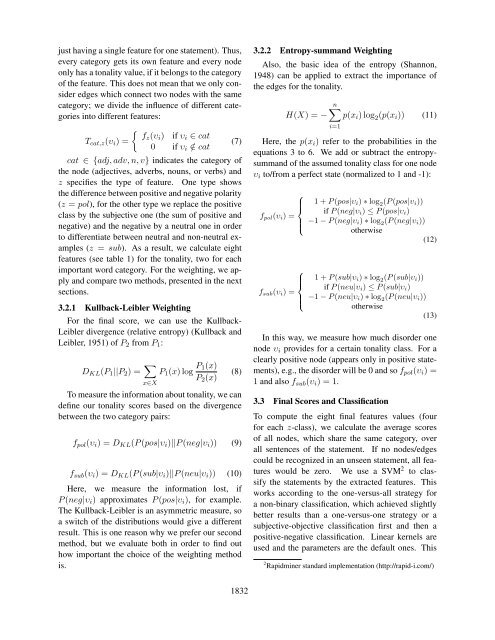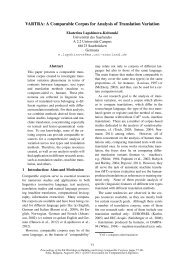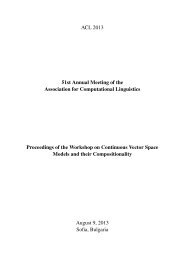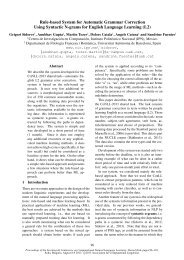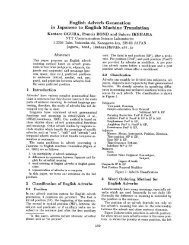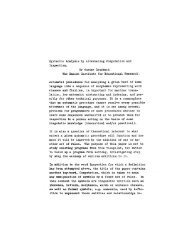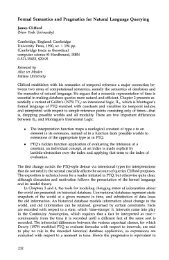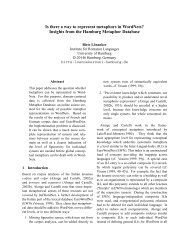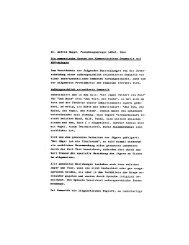Opinion Mining in Newspaper Articles by Entropy-Based Word ...
Opinion Mining in Newspaper Articles by Entropy-Based Word ...
Opinion Mining in Newspaper Articles by Entropy-Based Word ...
Create successful ePaper yourself
Turn your PDF publications into a flip-book with our unique Google optimized e-Paper software.
just hav<strong>in</strong>g a s<strong>in</strong>gle feature for one statement). Thus,<br />
every category gets its own feature and every node<br />
only has a tonality value, if it belongs to the category<br />
of the feature. This does not mean that we only consider<br />
edges which connect two nodes with the same<br />
category; we divide the <strong>in</strong>fluence of different categories<br />
<strong>in</strong>to different features:<br />
{<br />
fz (υ<br />
T cat,z (υ i ) = i ) if υ i ∈ cat<br />
(7)<br />
0 if υ i /∈ cat<br />
cat ∈ {adj, adv, n, v} <strong>in</strong>dicates the category of<br />
the node (adjectives, adverbs, nouns, or verbs) and<br />
z specifies the type of feature. One type shows<br />
the difference between positive and negative polarity<br />
(z = pol), for the other type we replace the positive<br />
class <strong>by</strong> the subjective one (the sum of positive and<br />
negative) and the negative <strong>by</strong> a neutral one <strong>in</strong> order<br />
to differentiate between neutral and non-neutral examples<br />
(z = sub). As a result, we calculate eight<br />
features (see table 1) for the tonality, two for each<br />
important word category. For the weight<strong>in</strong>g, we apply<br />
and compare two methods, presented <strong>in</strong> the next<br />
sections.<br />
3.2.1 Kullback-Leibler Weight<strong>in</strong>g<br />
For the f<strong>in</strong>al score, we can use the Kullback-<br />
Leibler divergence (relative entropy) (Kullback and<br />
Leibler, 1951) of P 2 from P 1 :<br />
D KL (P 1 ||P 2 ) = ∑ x∈X<br />
P 1 (x) log P 1(x)<br />
P 2 (x)<br />
(8)<br />
To measure the <strong>in</strong>formation about tonality, we can<br />
def<strong>in</strong>e our tonality scores based on the divergence<br />
between the two category pairs:<br />
f pol (υ i ) = D KL (P (pos|υ i )||P (neg|υ i )) (9)<br />
f sub (υ i ) = D KL (P (sub|υ i )||P (neu|υ i )) (10)<br />
Here, we measure the <strong>in</strong>formation lost, if<br />
P (neg|υ i ) approximates P (pos|υ i ), for example.<br />
The Kullback-Leibler is an asymmetric measure, so<br />
a switch of the distributions would give a different<br />
result. This is one reason why we prefer our second<br />
method, but we evaluate both <strong>in</strong> order to f<strong>in</strong>d out<br />
how important the choice of the weight<strong>in</strong>g method<br />
is.<br />
3.2.2 <strong>Entropy</strong>-summand Weight<strong>in</strong>g<br />
Also, the basic idea of the entropy (Shannon,<br />
1948) can be applied to extract the importance of<br />
the edges for the tonality.<br />
H(X) = −<br />
n∑<br />
p(x i ) log 2 (p(x i )) (11)<br />
i=1<br />
Here, the p(x i ) refer to the probabilities <strong>in</strong> the<br />
equations 3 to 6. We add or subtract the entropysummand<br />
of the assumed tonality class for one node<br />
υ i to/from a perfect state (normalized to 1 and -1):<br />
⎧<br />
1 + P (pos|υ i ) ∗ log ⎪⎨<br />
2 (P (pos|υ i ))<br />
if P (neg|υ<br />
f pol (υ i ) =<br />
i ) ≤ P (pos|υ i )<br />
−1 − P (neg|υ i ) ∗ log ⎪⎩<br />
2 (P (neg|υ i ))<br />
otherwise<br />
(12)<br />
⎧<br />
1 + P (sub|υ i ) ∗ log ⎪⎨<br />
2 (P (sub|υ i ))<br />
if P (neu|υ<br />
f sub (υ i ) =<br />
i ) ≤ P (sub|υ i )<br />
−1 − P (neu|υ i ) ∗ log ⎪⎩<br />
2 (P (neu|υ i ))<br />
otherwise<br />
(13)<br />
In this way, we measure how much disorder one<br />
node υ i provides for a certa<strong>in</strong> tonality class. For a<br />
clearly positive node (appears only <strong>in</strong> positive statements),<br />
e.g., the disorder will be 0 and so f pol (υ i ) =<br />
1 and also f sub (υ i ) = 1.<br />
3.3 F<strong>in</strong>al Scores and Classification<br />
To compute the eight f<strong>in</strong>al features values (four<br />
for each z-class), we calculate the average scores<br />
of all nodes, which share the same category, over<br />
all sentences of the statement. If no nodes/edges<br />
could be recognized <strong>in</strong> an unseen statement, all features<br />
would be zero. We use a SVM 2 to classify<br />
the statements <strong>by</strong> the extracted features. This<br />
works accord<strong>in</strong>g to the one-versus-all strategy for<br />
a non-b<strong>in</strong>ary classification, which achieved slightly<br />
better results than a one-versus-one strategy or a<br />
subjective-objective classification first and then a<br />
positive-negative classification. L<strong>in</strong>ear kernels are<br />
used and the parameters are the default ones. This<br />
2 Rapidm<strong>in</strong>er standard implementation (http://rapid-i.com/)<br />
1832


